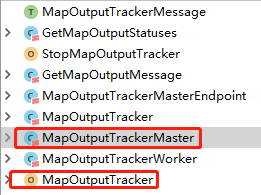val conf: SparkConf = new SparkConf().setAppName("WordCount").setMaster("local[*]")
val sc = new SparkContext(conf)短短两句代码背后,到底做了多少事情?
SparkContext
_env = createSparkEnv(_conf, isLocal, listenerBus)
SparkEnv.set(_env)SparkEnv最后的create方法的返回值
val envInstance = new SparkEnv(
executorId,
rpcEnv,
serializer,
closureSerializer,
serializerManager,//序列化管理器
mapOutputTracker, //map任务输出跟踪器
shuffleManager, //sort 和tungsten-sort 目前都是一样的
broadcastManager,//广播变量的管理器
blockManager, //块管理器
securityManager,//安全管理器
metricsSystem, //测量系统
memoryManager, //内存管理
outputCommitCoordinator,
conf)
// Add a reference to tmp dir created by driver, we will delete this tmp dir when stop() is
// called, and we only need to do it for driver. Because driver may run as a service, and if we
// don't delete this tmp dir when sc is stopped, then will create too many tmp dirs.
if (isDriver) {
val sparkFilesDir = Utils.createTempDir(Utils.getLocalDir(conf), "userFiles").getAbsolutePath
envInstance.driverTmpDir = Some(sparkFilesDir) //临时文件存放地
}
envInstanceSecurityManager
private val authOn = sparkConf.getBoolean(SecurityManager.SPARK_AUTH_CONF, false)
//上面那个是读取conf里的"spark.authenticate",判断是否开启
// Set our own authenticator to properly negotiate user/password for HTTP connections.
// This is needed by the HTTP client fetching from the HttpServer. Put here so its
// only set once.
if (authOn) {
Authenticator.setDefault(
new Authenticator() {
override def getPasswordAuthentication(): PasswordAuthentication = {
var passAuth: PasswordAuthentication = null
val userInfo = getRequestingURL().getUserInfo()
if (userInfo != null) {
val parts = userInfo.split(":", 2)
passAuth = new PasswordAuthentication(parts(0), parts(1).toCharArray())
}
return passAuth
}
}
)
}这个最后被赋值到
class Authenticator {
private static Authenticator theAuthenticator;mapOutputTracker
val mapOutputTracker = if (isDriver) {
new MapOutputTrackerMaster(conf, broadcastManager, isLocal)
} else {
new MapOutputTrackerWorker(conf)
}
MapStatus
private[spark] sealed trait MapStatus {
/** Location where this task was run. */
def location: BlockManagerId //方便reduce去哪里拉取
MapOutputTrackerMaster (dirver)
protected val mapStatuses = new ConcurrentHashMap[Int, Array[MapStatus]]().asScala
//这个key是mapid value是每个map的状态信息
private val cachedSerializedStatuses = new ConcurrentHashMap[Int, Array[Byte]]().asScala
//这个是维护序列化后的各个map任务的输出状态 key是shuffid
private val threadpool: ThreadPoolExecutor = {
val numThreads = conf.getInt("spark.shuffle.mapOutput.dispatcher.numThreads", 8)
val pool = ThreadUtils.newDaemonFixedThreadPool(numThreads, "map-output-dispatcher")
for (i <- 0 until numThreads) {
pool.execute(new MessageLoop) //开启线程执行messageloop
}
pool
}MessageLoop
private class MessageLoop extends Runnable {
override def run(): Unit = {
try {
while (true) {
try {
val data = mapOutputRequests.take()
if (data == PoisonPill) {
// Put PoisonPill back so that other MessageLoops can see it.
mapOutputRequests.offer(PoisonPill)
return
}
val context = data.context
val shuffleId = data.shuffleId
val hostPort = context.senderAddress.hostPort
logDebug("Handling request to send map output locations for shuffle " + shuffleId +
" to " + hostPort)
val mapOutputStatuses = getSerializedMapOutputStatuses(shuffleId)
context.reply(mapOutputStatuses)
} catch {
case NonFatal(e) => logError(e.getMessage, e)
}
}
} catch {
case ie: InterruptedException => // exit
}
}
}
mapOutputRequests 这是一个队列主要存MapOutputTrackerMasterEndpoint类中的receiveAndReply方法收取的消息
val mapOutputStatuses = tracker.post(new GetMapOutputMessage(shuffleId, context))shuffleManager
val shortShuffleMgrNames = Map(
"sort" -> classOf[org.apache.spark.shuffle.sort.SortShuffleManager].getName,
"tungsten-sort" -> classOf[org.apache.spark.shuffle.sort.SortShuffleManager].getName)
//这两个一样的 spark在骗自己呢,去掉了以前的hash
val shuffleMgrName = conf.get("spark.shuffle.manager", "sort")
val shuffleMgrClass = shortShuffleMgrNames.getOrElse(shuffleMgrName.toLowerCase, shuffleMgrName)
val shuffleManager = instantiateClass[ShuffleManager](shuffleMgrClass)
memoryManager
val useLegacyMemoryManager = conf.getBoolean("spark.memory.useLegacyMode", false)
val memoryManager: MemoryManager =
if (useLegacyMemoryManager) {
new StaticMemoryManager(conf, numUsableCores) //静态内存管理
} else {
UnifiedMemoryManager(conf, numUsableCores) //默认的 一般叫做动态内存管理
}UnifiedMemoryManager
object UnifiedMemoryManager {
// Set aside a fixed amount of memory for non-storage, non-execution purposes.
// This serves a function similar to `spark.memory.fraction`, but guarantees that we reserve
// sufficient memory for the system even for small heaps. E.g. if we have a 1GB JVM, then
// the memory used for execution and storage will be (1024 - 300) * 0.6 = 434MB by default.
private val RESERVED_SYSTEM_MEMORY_BYTES = 300 * 1024 * 1024//系统预留内存300M
def apply(conf: SparkConf, numCores: Int): UnifiedMemoryManager = {
val maxMemory = getMaxMemory(conf)
//默认=(Runtime.getRuntime.maxMemory-300M)*0.6 //以前好像是0.75
//如果spark.executor.memory 和Runtime.getRuntime.maxMemory比300*1.5小,报错
new UnifiedMemoryManager(
conf,
maxHeapMemory = maxMemory,
onHeapStorageRegionSize =
(maxMemory * conf.getDouble("spark.memory.storageFraction", 0.5)).toLong,
//堆内内存和对外内存一人一半
numCores = numCores)
}
blockManager
// NB: blockManager is not valid until initialize() is called later.
val blockManager = new BlockManager(executorId, rpcEnv, blockManagerMaster,
serializerManager, conf, memoryManager, mapOutputTracker, shuffleManager,
blockTransferService, securityManager, numUsableCores)metricsSystem
val metricsSystem = if (isDriver) {
// Don't start metrics system right now for Driver.
// We need to wait for the task scheduler to give us an app ID.
// Then we can start the metrics system.
MetricsSystem.createMetricsSystem("driver", conf, securityManager)
} else {
// We need to set the executor ID before the MetricsSystem is created because sources and
// sinks specified in the metrics configuration file will want to incorporate this executor's
// ID into the metrics they report.
conf.set("spark.executor.id", executorId)
val ms = MetricsSystem.createMetricsSystem("executor", conf, securityManager)
ms.start()
ms
}
outputCommitCoordinator
val outputCommitCoordinator = mockOutputCommitCoordinator.getOrElse {
new OutputCommitCoordinator(conf, isDriver)
}
val outputCommitCoordinatorRef = registerOrLookupEndpoint("OutputCommitCoordinator",
new OutputCommitCoordinatorEndpoint(rpcEnv, outputCommitCoordinator))
outputCommitCoordinator.coordinatorRef = Some(outputCommitCoordinatorRef)






















 2628
2628











 被折叠的 条评论
为什么被折叠?
被折叠的 条评论
为什么被折叠?








